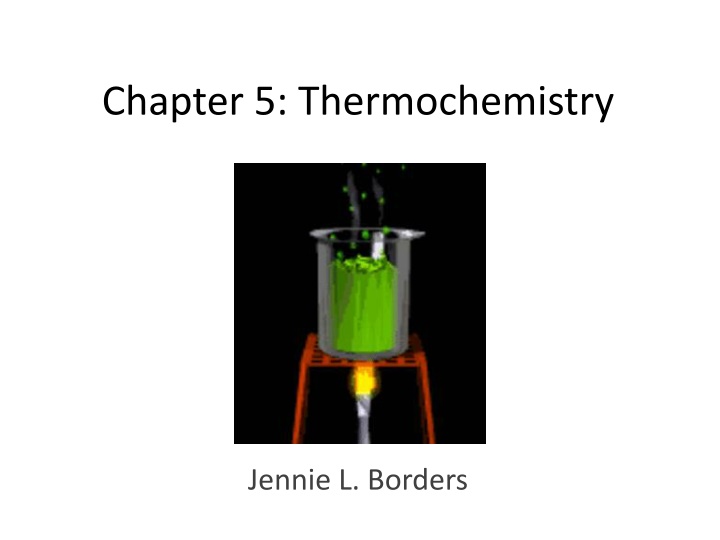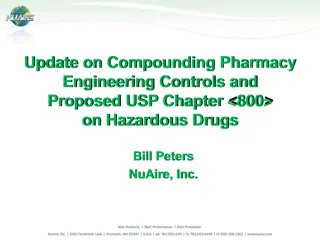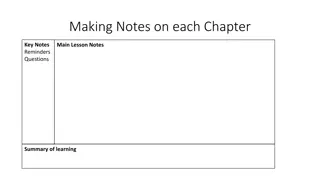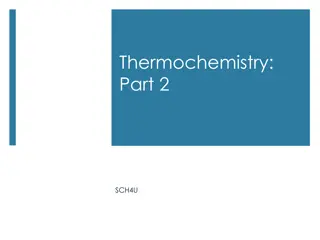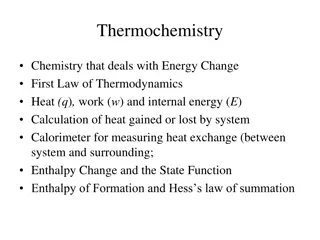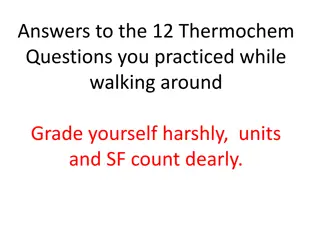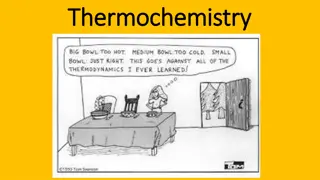Chapter 5: Thermochemistry
Thermochemistry, as explored in Chapter 5 by Jennie L. Borders, delves into the study of energy and its conversions, focusing on various forms such as kinetic, potential, electrostatic, chemical, and thermal energy. The chapter discusses concepts like work, heat, and the nature of energy in relation to chemical reactions. It also covers units of energy, system versus surroundings, and types of systems in the context of energy exchange.
Download Presentation

Please find below an Image/Link to download the presentation.
The content on the website is provided AS IS for your information and personal use only. It may not be sold, licensed, or shared on other websites without obtaining consent from the author.If you encounter any issues during the download, it is possible that the publisher has removed the file from their server.
You are allowed to download the files provided on this website for personal or commercial use, subject to the condition that they are used lawfully. All files are the property of their respective owners.
The content on the website is provided AS IS for your information and personal use only. It may not be sold, licensed, or shared on other websites without obtaining consent from the author.
E N D
Presentation Transcript
Chapter 5: Thermochemistry Jennie L. Borders
Section 5.1 The Nature of Energy Thermodynamics is the study of energy and its transformations. Energy is the ability to do work or transfer heat. Work is the energy used to cause an object with mass to move against a force. Heat is the energy used to cause the temperature of an object to increase.
Kinetic and Potential Energy Kinetic energy is the energy of motion. KE = mv2 Potential energy is the energy that an object possesses due to its position. PE = mgh
Electrostatic Potential Energy Electrostatic potential energy arises from the interactions between charged particles. Eel= kQ1Q2 d k = 8.99 x 109J.m/C2 Q1and Q2= a multiple of 1.60 x 10-10C (the charge of an electron) d = distance (m)
Electrostatic Potential Energy If Q1and Q2have the same charge, then Eelis positive and the charges repel. If Q1and Q2have opposite charges, then Eelis negative and the charges attract. Eeldecreases with increasing distance.
Chemical Energy Chemical energy is due to the potential energy stored in the arrangement of atoms. Thermal energy is the energy a substance possesses due to its temperature. Chemical energy and thermal energy are both important in chemical reactions.
Unit of Energy The SI unit for energy is the joule (J). 1J = 1kg.m2/s2 A calorie is another unit for energy. 1cal = 4.184J A Calorie (nutrition) is used in the food industry. 1Cal = 1000cal
System vs. Surroundings The system is the part of the universe in which we focus our attention (the reaction). The surrounding are anything that is not the system (the beaker, our hands, a solvent, a thermometer, etc.)
Systems An open system is one in which matter and energy can be exchanged with the surroundings. A closed system can exchange energy but not matter with its surroundings. An isolated system does not exchange energy or matter with the surroundings.
Work and Heat Work is energy used to move an object against a force. W = F x d Heat is energy transferred from a hotter object to a colder one.
Sample Exercise 5.1 A bowler lifts a 5.4kg (12 lb.) bowling ball from ground level to a height of 1.6m (5.2 feet) and then drops the ball back to the ground. a. What happens to the potential energy of the bowling ball as it is raised from the ground? b. What quantity of work, in J, is used to raise the ball? (Note: F = m x g)
Sample Exercise 5.1 cont c. After the ball is dropped, it gains kinetic energy. If we assume that all the work done in part b has been converted to kinetic energy by the time the ball strikes the ground, what is the speed of the ball at the instant just before it hits the ground? (Note: g = 9.8 m/s2)
Practice Exercise What is the kinetic energy, in J, of a. an Ar atom moving with a speed of 650 m/s? (1 amu = 1.66 x 10-24g) b. a mole of Ar atoms moving with a speed of 650 m/s?
Section 5.2 The First Law of Thermodynamics The first law of thermodynamics states that energy is conserved. Energy can transform from one form to another and can move to different places, but the overall energy must remain constant.
Internal Energy The internal energy (E) of a system is the sum of all the kinetic and potential energy of all of its components. Calculating E is difficult, but calculating DE is easier and more useful. DE = Ef Ei If DE is positive, then the system has gained energy. If DE is negative, then the system has lost energy.
DE DE = q + w When heat is added to a system or work is done on a system, its internal energy increases.
Sample Exercise 5.2 Two gases, A(g)and B(g), are confined in a cylinder- and-piston arrangement like that in Figure 5.3. Substances A and B react to form a solid product: A(g) + B(g) C(s). As the reaction occurs, the system loses 1150J of heat to the surroundings. The piston moves downward as the gases react to form a solid. As the volume of the gas decreases under the constant pressure of the atmosphere, the surroundings do 480J of work on the system. What is the change in the internal energy of the system?
Practice Exercise Calculate the change in the internal energy of the system for a process in which the system absorbs 140J of heat from the surroundings and does 85J of work on the surroundings.
Endothermic vs. Exothermic Endothermic is a process which absorbs heat from the surroundings. Exothermic is a process in which the system loses heat to the surroundings.
State Function A state function is a property of a system that is determined by a system s present state and not affected by the path taken to get there. DE is a state function. (Ex: 50g of hot water cooling to 25oC vs. 50g of ice warming to 25oC)
Section 5.3 - Enthalpy The work done by a chemical reactions consists of a volume change in the system. The work involved in the expansion or compression of gases is called pressure-volume work. Enthalpy is the heat flow of a system at constant pressure.
Sample Exercise 5.3 Indicate the sign of the enthalpy change, DH, in each of the following processes carried out under atmospheric pressure, and indicate whether the process is endothermic or exothermic: a. An ice cube melts b. 1g of butane (C4H10) is combusted in sufficient oxygen to give complete combustion to CO2and H2O.
Practice Exercise Suppose we confine 1g of butane and sufficient oxygen to completely combust it in a cylinder like that in Figure 5.12. The cylinder is perfectly insulating, so no heat can escape to the surroundings. A spark initiates combustion of the butane, which forms carbon dioxide and water vapor. If we used this apparatus to measure the enthalpy change in the reaction, would the piston rise, fall, or stay the same?
Section 5.4 Enthalpies of Reaction The enthalpy of reaction is the DH that occurs for a reaction (DHrxn). DHrxn= DHproducts DHreactants The thermochemical equation is a balanced reaction with the DH.
DH Enthalpy is an extensive property which means that it depends on the amount of substance. The enthalpy change for a reaction is equal in magnitude, but opposite in sign, to DH for the reverse reaction. The enthalpy change for a reaction depends on the state of the reactants and products.
Sample Exercise 5.4 How much heat is released when 4.50g of methane gas is burned in a constant-pressure system? CH4(g)+ 2O2(g) CO2(g)+ 2H2O(l) DH = -890 kJ
Practice Exercise Hydrogen peroxide can decompose to water and oxygen by the following reaction: 2H2O2(l) 2H2O(l)+ O2(g) DH = -196kJ Calculate the value of q when 5.00g of H2O2(l) decomposes at constant pressure.
Section 5.5 - Calorimetry A calorimeter is a device that measures the flow of heat in a reaction. Heat capacity is the amount of heat required to raise the temperature by 1K. Molar heat capacity (Cm) the amount of heat it takes to raise 1 mole of a substance 1K. Specific heat capacity (Cs) the amount of heat it takes to raise 1g of a substance 1K.
Heat q = mCDT
Sample Exercise 5.5 a.How much heat is needed to warm 250g of water (about 1 cup) from 22oC (about room temperature) to near its boiling point, 98oC? The specific heat of water is 4.18 J/gK b.What is the molar heat capacity of water?
Practice Exercise a.Large beds of rock are used in some solar-heated homes to store heat. Assume that the specific heat of the rocks is 0.82 J/gK. Calculate the quantity of heat absorbed by 50.0kg of rocks if their temperature increases by 12.0oC. b.What temperature change would these rocks undergo if they emitted 450kJ of heat?
Constant-Pressure Calorimetry The reactants and the products of a reaction are the system. Even a solvent (Ex. H2O) is considered the surroundings. In a calorimeter the heat change of the water equals the heat change of the reaction, but with the opposite sign. qsoln= -qrxn
Sample Exercise 5.6 When a student mixes 50mL of 1.0M HCl and 50mL of 1.0M NaOH in a coffee-cup calorimeter, the temperature of the resultant solution increases from 21.0oC to 27.5oC. Calculate the enthalpy change for the reaction in kJ/mol HCl, assuming that the calorimeter loses only a negligible quantity of heat, that the total volume of the solution is 100mL, that its density is 1.0g/mL, and that its specific heat is 4.18 J/gK.
Practice Exercise When 50.0mL of 0.100M AgNO3and 50.0mL of 0.100M HCl are mixed in a constant-pressure calorimeter, the temperature of the mixture increases from 22.30oC to 23.11oC. The temperature increase is caused by the following reaction: AgNO3(aq)+ HCl(aq) AgCl(s)+ HNO3(aq) Calculate DH for this reaction in kJ/mol AgNO3, assuming that the combined solution has a mass of 100.0g and a specific heat of 4.18J/goC.
Bomb Calorimeter A bomb calorimeter is used for constant volume calorimetry. qrxn= -Ccalx DT Ccalis the heat capacity of the water in the calorimeter.
Sample Exercise 5.7 Methylhdrazine (CH6N2) is used as a liquid rocket fuel. The combustion of methylhydrazine with oxygen produces N2(g), CO2(g), and H2O(l): 2CH6N2(l)+ 5O2(g) 2N2(g)+ 2CO2(g)+ 6H2O(l) When 4.00g of methylhydrazine is combusted in a bomb calorimeter, the temperature of the calorimeter increases from 25.00oC to 39.50oC. In a separate experiment the heat capacity of the calorimeter is measured to be 7.794 kJ/oC. Calculate the heat of reaction for the combustion of a mole of CH6N2.
Practice Exercise A 0.5865g sample of lactic acid (HC3H5O3) is burned in a calorimeter whose heat capacity is 4.812 kJ/oC. The temperature increases from 23.10oC to24.95oC. Calculate the heat of combustion of lactic acid a.Per gram b.Per mole
Section 5.6 HessLaw Hess law states that if a reaction is carried out in a series of steps, DH for the overall reaction will equal the sum of the enthalpy changes for the individual steps. When you flip a reaction, you change the sign of DH. When you multiply a reaction by a number, you do the same for DH. When you add the reactions, you add the DH s.
Sample Exercise 5.8 The enthalpy of reaction for the combustion of C to CO2is -393.5kJ/mol C, and the enthalpy for the combustion of CO to CO2is -283.0 kJ/mol CO: C(s)+ O2(g) CO2(g)DH = -393.5kJ CO(g)+ 1/2O2(g) CO2(g)DH = -283.0kJ Using these data, calculate the enthalpy for the combustion of C to CO: C(s)+ 1/2O2(g) CO(g)DH = ?
Practice Exercise Carbon occurs in two forms, graphite and diamond. The enthalpy of the combustion of graphite is -393.5 kJ/mol and that of diamond is -395.4 kJ/mol: C(graphite)+ O2(g) CO2(g) DH = -393.5kJ C(diamond)+ O2(g) CO2(g)DH = -395.4kJ Calculate DH for the conversion of graphite to diamond: C(graphite) C(diamond)DH = ?
Sample Exercise 5.9 Calculate DH for the reaction 2C(s)+ H2(g) C2H2(g) Given the following information chemical equations and their respective enthalpy changes: C2H2(g)+ 5/2O2(g) 2CO2(g)+ H2O(l) DH = -1299.6 kJ C(s)+ O2(g) CO2(g)DH = -393.5kJ H2(g)+ 1/2O2(g) H2O(l) DH = -285.8kJ
Practice Exercise Calculate DH for the reaction NO(g)+ O(g) NO2(g) Given the following information: NO(g) + O3(g) NO2(g)+ O2(g)DH = -198.9kJ O3(g) 3/2O2(g)DH = -142.3kJ O2(g) 2O(g)DH = 495.0kJ
Section 5.7 Enthalpies of Formation The enthalpy of formation (DHf) is the heat change that occurs with the formation of a substance from its elements. The standard enthalpy change (DHo) is the heat change that occurs with all reactants and products are at their standard states at 1 atm and 25oC. The standard enthalpy of formation (DHfo) for an element in its standard state is 0kJ/mol.
Sample Exercise 5.10 For which of the following reactions at 25oC would the enthalpy change represent a standard enthalpy of formation? For each that does not, what changes are needed to make it an equation whose DH is an enthalpy of formation? a. 2Na(s) + 1/2O2(g) Na2O(s) b. 2K(l)+ Cl2(g) 2KCl(s) c. C6H12O6(s) 6C(diamond)+ 6H2(g)+ 3O2(g)
Practice Exercise Write the equation corresponding to the standard enthalpy of formation of liquid carbon tetrachloride (CCl4):
Standard Enthalpy of Formation DHrxn= SDH(products) SDH(reactants)
Sample Exercise 5.11 a. Calculate the standard enthalpy change for the combustion of 1 mol of benzene, C6H6(l), to form CO2(g)and H2O(l). b. Compare the quantity of heat produced by combustion of 1.00g propane to that produced by 1.00g benzene.
Practice Exercise Using the standard enthalpies of formation listed in Table 5.3, calculate the enthalpy change for the combustion of 1 mol of ethanol: C2H5OH(l)+ 3O2(g) 2CO2(g)+ 3H2O(l)
Sample Exercise 5.12 The standard enthalpy change for the reaction CaCO3(s) CaO(s)+ CO2(g) Is 178.1kJ. From the values for the standard enthalpies of formation of CaO(s)and CO2(g)given in Table 5.3, calculate the standard enthalpy of formation of CaCO3(s).
